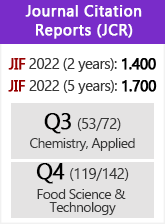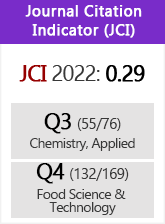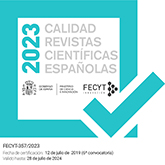Enzyme-aided cold pressing of flaxseed (Linum usitatissimum L.): Enhancement in yield, quality and phenolics of the oil
DOI:
https://doi.org/10.3989/gya.132212Keywords:
Antioxidant Properties, Carbohydrases, Cold pressed oil, HPLC, Linolenic acid, Phenolic acids, Physicochemical-parameters, Tocopherols, TPCAbstract
The effect of different enzyme preparations (Viscozyme L, Kemzyme, and Feedzyme) on the yield and physicochemical and antioxidant properties of cold pressed flaxseed oil were assessed. The oil yield (35.2-38.0%) from enzyme-treated cold pressed flaxseeds (ETCPF), although lower than Soxhlet extracted oil (SEO) yield, was considerably higher when compared with the control (32.5%) while the contents of protein, fiber, and ash were unaffected by the enzymatic treatment. Most of the physicochemical parameters such as refractive index, density, iodine number, free fatty acid contents, saponification value, color and fatty acid profile did not vary significantly among the ETCPF oil, SEO and the control. Interestingly, the oxidation status in terms of peroxide value, para-anisidine value, conjugated dienes and triens and induction period (Rancimat method) as well as the sensory score of the ETCPF oil were superior compared with the control. An appreciably higher amount of tocopherols (350-400 mg kg–1) was determined in the ETCPF oil, compared to the control (270 mg kg–1), showing an increase of 22.8-32.5% in the recovery of total tocopherols. Moreover, ETCPF oil exhibited greater antioxidant activity as well as total phenolics and individual phenolic acid content. This study advocates the exploration of enzyme-assisted cold pressing as a viable alternative to conventional cold-pressing for improving not only the extraction yield but also the functional food quality of flaxseed-like high-value oils.
Downloads
References
Abdulkarim SM, Long K, Lai OM, Muhammad SKS, Ghazali HM. 2005. Some physico-chemical properties of Moringa oleifera seed oil extracted using solvent and aqueous enzymatic methods. Food Chem. 93, 253-263. http://dx.doi.org/10.1016/j.foodchem.2004.09.023
American Oil Chemists Society (AOCS). 1997. Official and Recommended Practices of the American Oil Chemists Society, 5th edn., AOCS Press, Champaign, Illinois, USA.
Association of Official Analytical Chemists (AOAC). 1990. Official Methods of Analysis of the Association of Official Analytical Chemists, 15th edition, AOAC Inc., Virginia.
Anwar F, Latif S, Przybylski R, Sultana B, Ashraf M. 2007. Chemical composition and antioxidant activity of seeds of different cultivars of mungbean. J. Food Sci. 72, S503-S510. http://dx.doi.org/10.1111/j.1750-3841.2007.00462.x PMid:17995664
Anwar F., Przybylski R. 2012. Effect of solvents extraction on total phenolics and antioxidant activity of extracts from flaxseed (Linum usitatissimum L.). Acta Sci. Pol. Technol. Aliment. 11, 293-301. PMid:22744950
Bylund A, Saarinen N, Zhang JX, Bergh A, Widmark A, Johansson A, Lundin E, Adlercreutz H, Hallmans G, Stattin P, Makela S. 2005. Anticancer effects of a plant lignan 7-hydroxymatairesinol on a prostate cancer model in vivo. Experimental Biol. Medicine. 230, 217-223.
Daun JK, Barthet VJ, Chornick TL, Dugiud S.2003. Structure, composition and variety development of flaxseed. Thompson I. U., Cannane, S.C. (Eds.), Flaxseed in Human Nutrition. AOCS Press. Champaign, USA, 1- 40.
Gao, M. and Liu, CZ. 2006. Dynamic microwave assisted extraction of flavonoids from Saussurea medusa maximum culture cells. J. Biochem. Eng. 32, 79-83. http://dx.doi.org/10.1016/j.bej.2006.09.004
Herchi W, Sawlha S, Arraez D, Boukhchina S, Carretero A, Kallel H, utierrezz AF. 2011. Determination of phenolic and other polar compounds in flax seed oil using liquid chromatography with time- of -flight mass spectrometry. Food Chem. 126, 332-338. http://dx.doi.org/10.1016/j.foodchem.2010.10.070
Hosseinian FS, Muir AD, Westcott ND, Krol ES. 2006. Antioxidant capacity of flaxseed lignans in two model systems. J. Am. Oil Chem. Soc. 83, 835-840. http://dx.doi.org/10.1007/s11746-006-5034-x
Hussain S, Anjum FM, Alamri MS. 2011. Fortification of pan bread with healthy flaxseed. Aus. J. Basic. App. Sci. 5, 978-983.
International Standards Organization (ISO). Animal Feeding Stuffs -Determination of Nitrogen and Calculation of Crude Protein Content; ISO: Geneva, Switzerlanld, 1981; Standard 5983.
International Standards Organization (ISO). Oilseed Residues- Determination of Total Ash; ISO: Geneva, Switzerland, 1977; Standard 749.
IUPAC. Standard Methods for the Analysis of Oils, Fats and Derivatives, 7th revised Edn. International Union of Pure and Applied Chemistry, Blackwell Scientific, London 1987.
Kaufmann B, Christen P. 2002. Recent extraction techniques for natural products: microwave-assisted extraction and pressurised solvent extraction. Phytochem. Anal. 13, 105-113. http://dx.doi.org/10.1002/pca.631 PMid:12018022
Kouba M. 2006. Effect of dietary omega-3 fatty acids on meat quality of pigs and poultry. In: MCT Eagle (ed). Omega 3 Fatty Acid Research. Nova Publishers. New York, USA, pp. 225-239
Latif S, Anwar F. 2011. Aqueous enzymatic sesame oil and protein extraction. Food Chem. 125, 679-684. http://dx.doi.org/10.1016/j.foodchem.2010.09.064
Latif S, Anwar F, Ashraf M. 2007. Characterization of enzyme-assisted cold pressed cotton seed oil. J. Food Lipids. 14, 424-436. http://dx.doi.org/10.1111/j.1745-4522.2007.00097.x
Latif S, Anwar F, Hussain AI, Shahid M. 2011. Aqueous enzymatic process for oil and protein extraction from Moringa oleifera seed, Eur. J. Lipid Sci. Technol. 11, 1012-1018 http://dx.doi.org/10.1002/ejlt.201000525
Latif S, Anwar F. (2009). Physico-chemical studies of hemp (Cannabis sativa) seed oil using enzymeassisted cold pressing. Eur. J. Lipid Sci. Technol. 10, 1042-1048. http://dx.doi.org/10.1002/ejlt.200900008
Maillard V, Bougnoux P, Ferrari P, Jourdan ML, Pinault M, Lavillonniere F, Body G, Le Floch O, Chajes V. 2002. n-3 and n-6 fatty acids in breast adipose tissue and relative risk of breast cancer in a case-control study in Tours France. Int. J. Cancer. 98:78-83 http://dx.doi.org/10.1002/ijc.10130 PMid:11857389
Matthews KR, Homer DB, Thies F, Calder PC.2000. Effect of whole linseed (Linum usitatissimum L) in the diet of finishing pigs on growth performance and on the quality and fatty acid composition of various tissues. British J. Nutrition. 83, 637-643. http://dx.doi.org/10.1017/S0007114500000817 PMid:10911772
Mc Cann SE, Kulkarni S, Trevisan M, Vito D, Nie J, Edge SB, Muti P, Freundenheim JL. 2006. Dietary lignan intakes and risk of breast cancer by tumor estrogen receptor status. Breast Cancer Res. Treatment. 99, 309-311. http://dx.doi.org/10.1007/s10549-006-9196-x PMid:16541305
Min DB. 1983. Analyses of flavor qualities of vegetable oils by gas chromatography. J. Am. Oil Chem. Soc. 60, 544-545. http://dx.doi.org/10.1007/BF02679783
Moure A, Dominguez H, Zuniga ME, Carmen S, Chamy R. 2002. Characterization of protein concentrates from pressed cakes of Guevina avellana (Chilean hazelnut). Food Chem. 78, 179-186. http://dx.doi.org/10.1016/S0308-8146(01)00397-1
Oomah B D. 2001. Flaxseed as a functional food source. J. Agric. Food Chem. 81, 889-894. http://dx.doi.org/10.1002/jsfa.898
Parry J, SU L, Luther M, Zhou K, Yurawecz MP, Whittaker P, 2005. Fatty acid composition and antioxidant properties of cold-pressed marionberry, boysenberry, red raspberry, and blueberry seed oils. J. Agric. Food Chem. 53, 566-573. http://dx.doi.org/10.1021/jf048615t PMid:15686403
Ranalli A, De Mattia G. 1997. Characterization of olive oil produced with a new enzyme processing aid. J. Am Oil Chem. Soc., 74, 1105-1113. http://dx.doi.org/10.1007/s11746-997-0032-1
Ranalli A, Malfatti A, Lucera L, Contento S, Sotiriou E. 2005. Effects of processing techniques on the natural colorings and the other functional constituents in virgin olive oil. Food Res. Int. 38, 873-878. http://dx.doi.org/10.1016/j.foodres.2005.02.011
Riley PA, Enser M, Nute GR, Wood JD. 2000. Effects of dietary linseed on nutritional value and other quality aspects of pig muscle and adipose tissue. Animal Sci. 71, 483-500.
Schaefer EJ. 2002. Lipoproteins, nutrition, and heart disease. Am. J Clin. Nutr. 75, 191-212 PMid:11815309
Siger A, Malgorzata NK, Eleonora LS. 2008. The content and antioxidant activity of phenolic compounds in cold-pressed plant oils. J. Food Lipids 15, 137-149. http://dx.doi.org/10.1111/j.1745-4522.2007.00107.x
Singh RK, Sarker BC, Kumbhar BK. 1999. Response surface analysis of enzyme assisted oil extraction factors for sesame, groundnut and sunflower seeds. J. Food Sci. Technol. 36, 511-514.
Soto CG, Chamy R, Zuniga M. 2004. Effect of enzymatic application on Borage (Borago officinalis) oil extraction by cold pressing. J. Chem. Eng. Japan. 37, 326-331. http://dx.doi.org/10.1252/jcej.37.326
Steel, F, Torrie GJH and Dickey DA. 1997. Principals and procedures of biometrical approach 3rd edition. W. C. McGraw Hill, New York
Tarpila A, Wennberg T, Tarpila S, 2005. Flaxseed as a functional food. Curr. Top. Nutrac. Res. 3, 167-188.
Tzen JTC, Huang AHC. 1992. Surface structure and properties of plant seed oil bodies. J. of biological chem. 117, 327-335.
Westcott ND, Muir AD. 2003. Flaxseed lignan in disease prevention and health promotion. Phytochem. Rev. 2, 401-417. http://dx.doi.org/10.1023/B:PHYT.0000046174.97809.b6
Wrolstad RE. 2003 in: Wrolstad, R. E. (Ed.), Current Protocols in Food Analytical Chemistry (CPFA), John Wiley & Sons, UK, pp. 6902-6904.
Yen GC, Duh PD, Chuang DY. 2000. Antioxidant activity of anthraquinones and anthrone. Food Chem. 70, 307-315. http://dx.doi.org/10.1016/S0308-8146(00)00108-4
Zuniga ME, Chamy R, Lema JM. 2001. Canola and Chilean hazelnut products obtained by enzymeassisted cold-pressed oil extraction. In Proceedings of the world conference and exhibition on oilseed processing and utilization (R.F. Wilson, ed.). AOCS Press, Champaign, pp. 210-213.
Downloads
Published
How to Cite
Issue
Section
License
Copyright (c) 2013 Consejo Superior de Investigaciones Científicas (CSIC)

This work is licensed under a Creative Commons Attribution 4.0 International License.
© CSIC. Manuscripts published in both the printed and online versions of this Journal are the property of Consejo Superior de Investigaciones Científicas, and quoting this source is a requirement for any partial or full reproduction.All contents of this electronic edition, except where otherwise noted, are distributed under a “Creative Commons Attribution 4.0 International” (CC BY 4.0) License. You may read here the basic information and the legal text of the license. The indication of the CC BY 4.0 License must be expressly stated in this way when necessary.
Self-archiving in repositories, personal webpages or similar, of any version other than the published by the Editor, is not allowed.
















